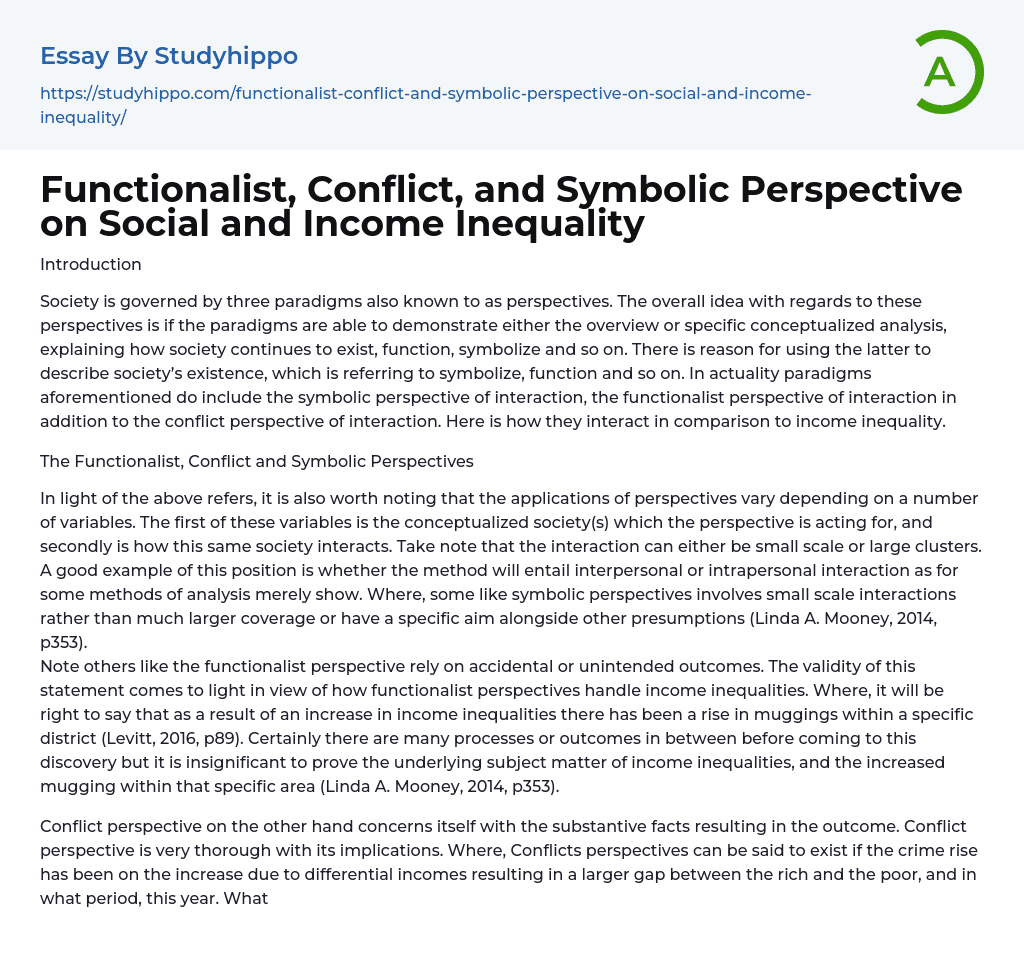

Functionalist, Conflict, and Symbolic Perspective on Social and Income Inequality Essay Example
Introduction
Society is governed by three paradigms also known to as perspectives. The overall idea with regards to these perspectives is if the paradigms are able to demonstrate either the overview or specific conceptualized analysis, explaining how society continues to exist, function, symbolize and so on. There is reason for using the latter to describe society’s existence, which is referring to symbolize, function and so on. In actuality paradigms aforementioned do include the symbolic perspective of interaction, the functionalist perspective of interaction in addition to the conflict perspective of interaction. Here is how they interact in comparison to income inequality.
The Functionalist, Conflict and Symbolic Perspectives
In light of the above refers, it is also worth noting that the applications of perspectives vary depending on a number of variables. The first of these variables is
...the conceptualized society(s) which the perspective is acting for, and secondly is how this same society interacts. Take note that the interaction can either be small scale or large clusters. A good example of this position is whether the method will entail interpersonal or intrapersonal interaction as for some methods of analysis merely show. Where, some like symbolic perspectives involves small scale interactions rather than much larger coverage or have a specific aim alongside other presumptions (Linda A. Mooney, 2014, p353).
Note others like the functionalist perspective rely on accidental or unintended outcomes. The validity of this statement comes to light in view of how functionalist perspectives handle income inequalities. Where, it will be right to say that as a result of an increase in income inequalities there has been a rise in muggings within a specific district (Levitt, 2016, p89). Certainly there ar
many processes or outcomes in between before coming to this discovery but it is insignificant to prove the underlying subject matter of income inequalities, and the increased mugging within that specific area (Linda A. Mooney, 2014, p353).
Conflict perspective on the other hand concerns itself with the substantive facts resulting in the outcome. Conflict perspective is very thorough with its implications. Where, Conflicts perspectives can be said to exist if the crime rise has been on the increase due to differential incomes resulting in a larger gap between the rich and the poor, and in what period, this year. Whatever happened last year will cease to matter as long as it is clear what year it is, and why and where the message conveyed is coming from (Linda A. Mooney, 2014, p353).
At last is the Symbolic perspectives; the reader will find that many of the perspectives implementation phases will often require the use of face to face interactions. Stating things differently is to say symbolic perspective will often ask why people think income inequalities have increased in the rate of mugging this year on an individual basis. Every thought according to symbolic perspective is therefore valid, provided it explains why income inequality has increased in mugging. The interactionism creates meaning to the holder of the information, according George Herbert (Prus, 1996, p116-117).
Interestingly sociologists often confuse functionalist and symbolic perspectives. Perhaps it is because they both regard the trueness of interpersonal nature or the two way system it has developed for, aimed at achieving specific results unlike that associated with conflict. However, the difference lies in the regarding the specific problem to be addressed and hypothesis to
be examined. Functionalist on the other hand seems to go with the flow regardless of whether or not anyone agrees with it. In relation to the aforementioned paragraphs, the reader should be increasingly becoming aware of the manifestation of the paradigms how, as well where and when to apply them (Skidmore, 1975, p3).
Conclusion
The paper has demonstrated beyond reasonable doubt the relationship social has on income inequality. In a demonstration constructed to define the said perspectives. Each unique in character and showing how they work together. The paper has demonstrated how.
Reference
- Levitt, S. D. (2016). The changing relationship between income and crime victimization. Retrieved April 12, 2016, from Newyorkfed.org: https://www.newyorkfed.org/medialibrary/media/research/epr/99v05n3/9909levi.pdf
- Linda A. Mooney, D. K. (2014). Understanding Social Problems. New York: Cengage Learning.
- Prus, R. C. (1996). Symbolic Interaction and Ethnographic Research: Intersubjectivity and the Study of Human Lived Experience. New York: Suny Press.
- Skidmore, W. (1975). Sociology's Models of Man: The Relationships of Models of Man to Sociological Explanation in Three Sociological Theories. New York: Taylor & Francis.
- Income Inequality In America essays
- American Dream essays
- Barriers To Entry essays
- Capitalism essays
- Central Bank essays
- Compensation essays
- Consumerism essays
- Economic Development essays
- Economic Growth essays
- Economic Inequality essays
- Economic System essays
- Economy essays
- Employment essays
- Export essays
- Finance essays
- Free Trade essays
- Gross Domestic Product essays
- Human Development essays
- Income Inequality essays
- Industry essays
- Inflation essays
- International Business essays
- International Trade essays
- Macroeconomics essays
- Materialism essays
- Max Weber essays
- Microeconomics essays
- Minimum Wage essays
- Monetary Policy essays
- Monopoly essays
- Pricing essays
- Profit essays
- Recession essays
- resources essays
- Taxation essays
- Trade essays
- Unemployment essays
- Warehouse essays
- World economy essays
- Equality essays
- Gender equality essays
- Gender Inequality essays
- Minority essays
- Segregation essays
- Social Inequality essays



